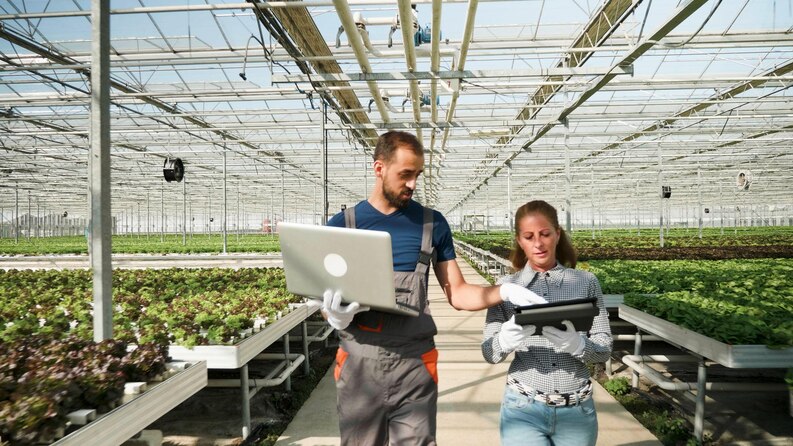With urbanization on its fast lane and cities expanding at an unprecedented rate the case for locally-sourced sustainable food production becomes more pressing every day. The United Nations says that by 2050 nearly 68% of the world’s population will be expected to live in urban areas. Rural and water-intensive/fine supply chains of traditional agricultural systems cannot possibly sustain the global agro demands coming from such ultra-dense surroundings. This question has been giving birth to urban farming technology leading AOT that snuggled its root in the fabric of cities between advanced agro innovation. Urban farming using key strategies of hydroponic, aeroponics, vertical farming, smart monitoring systems and Artificial Intelligence have the potential to not just deal with food security but also achieve the goal towards environmental sustainability, and economic resilience for urban cities.
Technology Used in Urban Farming
The technological infrastructure underpinning modern urban farming is both sophisticated and continually evolving. Hydroponic systems, which enable the cultivation of crops without soil by using mineral nutrient solutions in an aqueous solvent, have gained widespread adoption. Studies conducted by the United States Department of Agriculture (USDA) indicate that hydroponic cultivation can reduce water usage by up to 90% compared to traditional soil-based agriculture, making it particularly advantageous for urban settings where resource conservation is critical.
In addition to hydroponics, aeroponics has even more efficiency than that. First developed by NASA for growing crops in space, aeroponics is a zero-soil cultivation system that suspends the roots of seedlings in the air and delivers plant nutrients as a nutrient mist, allowing around 95% water savings versus standard agriculture and much faster growth rates. While the vertical farming model not only radically reinvents urban agriculture by maximizing yields per sqm; research, published in the Journal of Agricultural Studies reveals that a vertical farm can produce 10–20 times the crops in the same footprint as a horizontal farm.
Moreover, the use of LED grow lighting emits a mix of light wavelengths the plants need for photosynthesis allows for year-round growing with 60% less energy than current high-pressure sodium lights (HPS). Sensors to measure temperature, humidity, CO₂ balance and nutrient concentrations attach to the plant to provide real-time data for an automated environment that enhances the use of resources overall by 20–30% using precision agriculture tools based on IoT. Another update driven by artificial intelligence and machine learning algorithms further refines operations to schedule optimal planting times, solve any pest threats, and even read and adjust harvest moments (yield improvements of +15% or so) such as.
How Does Urban Farming Work?
Urban farming: practice of modifying agricultural technologies to fit into urban environment with technological, controlled-space replication of ideal growing environment in cities. At its foundation, urban farming is a Controlled Environment Agriculture (CEA) of maintaining all environmental conditions compatible with specific plant requirements for light, humidity temperature, nutrient delivery and airflow to consistently get robust high yield production year around. This is the reason why urban farms can land on rooftop spaces, empty warehouses, subterranean bunkers and even repurposed shipping containers.
Urban farming is based off the philosophy of local food production. Cities growing crops means that supply chains for a typical farmer are reduced by about 70%, just as the World Resources Institute said through food transport emissions. It also means that systems can scale up as needed for increased scale of operations while still operating at best efficiency through the use of modular and scalable urban farms. Water recirculating systems, solar panels and other renewable energies integration (to collect energy) Try achieve minimum footprint on both fronts. Urban farms can be as little as one percent of the cropland and ten percent of the water needed for conventional outdoor agriculture in many cases, according to University of Arizona controlled environment agriculture studies.
By decoupling food production from climate variability and geographic limitations, urban farming ensures a stable, year-round supply of fresh produce, a concept that is increasingly critical in the face of climate change, supply chain disruptions, and growing urban food deserts.
What Is an Example of Urban Farming?
In practice and scale, the proof of urban farming technologies is seen in a few critical world projects that have already demonstrated success with flagship projects. Gotham Greens, a vertically integrated urban farm based in New York City which grows over 20 million heads of lettuce annually on its hydroponic skyscraper greenhouses as well as being powered by 100% renewable electricity and using less than 1/10th of the water used in conventional farming. This success highlights that highly scalable food production can take place within urban infrastructure without derailing sustainability.
Singapore’s Sky Greens is the world’s first commercial vertical farm in Asia, a hydraulic driven rotating tower system to increase sunlight and yields significantly from their scientific studies. The vertical Grow Towers of Sky Greens can grow vegetables at ten times denser than in a conventional field farm.
In Europe, infirm deploys modular vertical farming units directly inside supermarkets and restaurants, offering hyper-local produce cultivation that eliminates transportation emissions entirely. By growing herbs and greens on-site, infirm reduces post-harvest losses which normally account for up to 45% of leafy green wastage to virtually zero.
Meanwhile, Growing Underground in London operates a hydroponic farm in a repurposed World War II bomb shelter, leveraging consistent underground temperatures to produce pesticide-free microgreens and leafy vegetables. This innovative approach highlights how disused urban spaces can be transformed into productive agricultural hubs.
Each of these examples illustrates not only the flexibility and adaptability of urban farming but also its potential to fundamentally reshape global food systems in the face of mounting urban challenges.
Urban Farming Business
Building a profitable urban farming business demands strategic planning, significant technological investment, and a deep understanding of both agricultural science and urban market dynamics. Market research consistently shows that high-value crops such as microgreens, specialty herbs, and premium salad greens are the most economically viable options for urban farms, offering profit margins that can reach $30–$50 per square foot annually.
Small modular (i.e., $100,000) and large-scale (over $1 million for full automated vertical farming facilities) urban farm operations have widely varying capital outlays dependent upon scale, scope and technology sophistication. Still, the initial expenses are frequently covered in long term savings related to less water use, cheaper transportation and year-round crops.
Expertise is required above all in the operational dimension. Urban farms are usually led by agronomist, environmental engineer and data scientists working side by side through to their farm cropping operation (hands on), to standing environmental control, data analytics readings Successful farms invariably have all three of these hugely important roles.
Other revenue streams of importance, direct-to-consumer sales as well as restaurant partnerships with CSA (community supported agriculture) subscriptions and educational workshops expand the financial footprint.
Consistent with a Grand View Research, 2022 report, the urban farming market is anticipated to grow at a CAGR of 7.4% during the forecast period (2022 – 2030) and amount to around US$ 24 billion by 2030. What this optimistic state of affairs suggests is a perfect storm of consumer preference away from less sustainable, off-the-shelf in favor of locally sourced foodstuffs and technology ramped up sufficiently to make it happen.
Conclusion
Urban farming technology is about a paradigm shift in how we can solve food security, city farming or urbanization and environmental sustainability. With hydroponics, aeroponics, vertical farming architectures fully interconnected via IoT-precision agriculture and AI-influenced resource management the urban agriculture becomes a viable and rapidly leaning indispensable solution to feeding the ever-growing number of urbanites worldwide. Universal City, our examples led by pioneering companies around the globe show that with the right technology, talent & vision cities can become sustainable ecosystems that are good for both people and the planet. Investing in urban farming, as we move forward to a world ruled by climate change and urbanization is not only a radical agricultural idea; instead, it becomes the most critical solution to conducive sustainable and vibratory communities.


